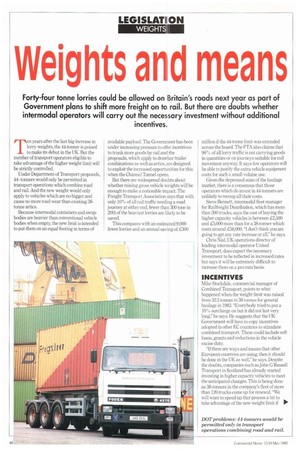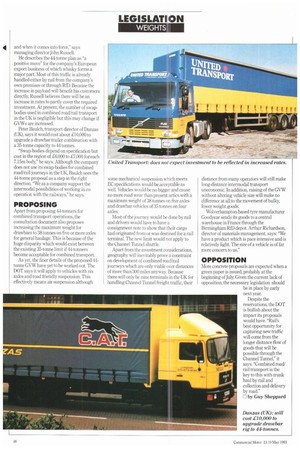Weights and means
Page 48

Page 50

If you've noticed an error in this article please click here to report it so we can fix it.
Ten years after the last big increase in lorry weights, the 44-tonner is poised to make its debut in the UK. But the number of transport operators eligible to take advantage of the higher weight limit will be strictly controlled.
Under Department of Transport proposals, 44Wailers would only be permitted in transport operations which combine road and rail And the new weight would only apply to vehicles which are no bigger and cause no more road wear than existing 38tonne artics.
Because intermodal containers and swapbodies are heavier than conventional vehicle bodies when empty, the new limit is intended to put them on an equal footing in terms of available payload. The Government has been under increasing pressure to offer incentives to trunk more goods by rail and the proposals, which apply to drawbar trailer combinations as well as artics, are designed to exploit the increased opportunities for this when the Channel Tunnel opens, But there are widespread doubts about whether raising gross vehicle weights will be enough to make a noticeable impact. The Freight Transport Association says that with only 10% of all rail traffic needing a road journey at either end, fewer than 300 (one in 200) of the heaviest lorries are likely to be saved.
This compares with an estimated 9,000 fewer lorries and an annual saving of £300 million if the 44-tonne limit was extended across the board. The FTA also claims that 96% of all loriT traffic is not carrying goods in quantities or on journeys suitable for rail movement anyway It says few operators will be able to justify the extra vehicle equipment costs for such a small volume use.
Given the depressed state of the haulage market, there is a consensus that those operators which do invest in 44-tonners are unlikely to recoup all their costs.
Steve Bennett, intermodal fleet manager for Railfreight Distribution, which has more than 300 trucks, says the cast of buying the higher capacity vehicles is between £2,500 and 45,000 more than for a 38-tonner which costs around £56,000. "I don't think you are going to get any rate increase at all," he says.
Chris Nial, UK operations director of leading intermodal operator United Transport, does expect the necessary investment to be reflected in increased rates but says it will be extremely difficult to increase them on a pro-ram basis.
INCENTIVES
Mike Stockdale, commercial manager of Combined Transport, points to what happened when the weight limit was raised from 32.5 tonnes to 38 torme8 for general haulage in 1983. "Everybody tried to put a 10% surcharge on but it did not last very long," he says. He suggests that the UK Government will have to copy incentives adopted in other EC countries to stimulate combined transport. These could include soft loans, grants and reductions in the vehicle excise duty
"If there are ways and means that other European countries are using, then it should be done in the UK as well," he says. Despite the doubts, companies such as John G Russell Transport in Scotland has already started investing in higher capacity vehicles to meet the anticipated changes. This is being done as 38-tonners in the company's fleet of more than 120 trucks come up for renewal. We will want to speed up that process a bit to take advantage of the new weight limit if Ot• and when it comes into force," says managing director John Russell.
He describes the 44-tonne plan as "a positive move" for the company's European export business of which whisky forms a major part. Most of this traffic is already handled either by rail from the company's own premises or through RfD. Because the increase in payload will benefit his customers directly, Russell believes there will be an increase in rates to partly cover the required investment. At present, the number of swapbodies used in combined road/rail transport in the UK is negligible but this may change if GVWs are increased.
Peter Baulch, transport director of Danzas (UK), says it would cost about £10,000 to upgrade a drawbar trailer combination with a 35-tonne capacity to 44 tonnes.
"Swap-bodies depend on specification but cost in the region of £6,000 to £7,000 for each 7.15m body," he says. Although the company does not use its swap-bodies for combined road/rail journeys in the UK, Baulch sees the 94-tonne proposal as a step in the right direction. "We as a company support the intermodal possibilities of working in cooperation with the railways," he says.
Apart from proposing 44-tonners for combined transport operations, the consultation document also proposes increasing the maximum weight for drawbars to 38 tonnes on five or more axles for general haulage. This is because of the huge disparity which would exist between the existing 35-tonne limit if 44-tonners become acceptable for combined transport, As yet, the finer details of the proposed 44tonne GVW have yet to be worked out. The DOT says it will apply to vehicles with six axles and road friendly suspension. This effectively means air suspension although some mechanical suspension which meets EC specifications would be acceptable as well. Vehicles would be no bigger and cause no more road wear than present artics with a maximum weight of 38 tonnes on five axles and drawbar vehicles of 35 tonnes on four axles.
Most of the journey would be done by rail and drivers would have to have a consignment note to show that their cargo had originated from or was destined for a rail terminal. The new limit would not apply to the Channel Tunnel shuttle.
Apart from the investment considerations, geography will inevitably prove a constraint on development of combined road/rail journeys which are only viable over distances of more than 300 miles anyway. Because there will only be nine terminals in the UK for handling Channel Tunnel freight traffic, their distance from many operators will still make long-distance intermodal transport uneconomic. In addition, raising of the GVW without altering vehicle size will make no difference at all to the movement of bulky, lower weight goods.
Wolverhampton-based tyre manufacturer Goodyear sends its goods to a central warehouse in France through the Birmingham RfD depot. Arthur Richardson, director of materials management, says: "We have a product which is pace intensive and is relatively light. The size of a vehicle is of far more concern to us," More concrete proposals are expected when a green paper is issued, probably at the beginning of July. Given the current lack of opposition, the necessary legislation should be in place by early next year.
Despite the reservations, the DOT is bullish about the impact its proposals would have. "Rail's best opportunity for capturing new traffic will come from the longer distance flow of goods that will be possible through the Channel Tunnel," it says. "Combined road/ rail transport is the key to this with trunk haul by rail and collection and delivery by road,"
El by Guy Sheppard
































































































































